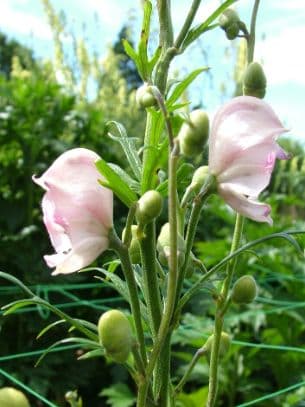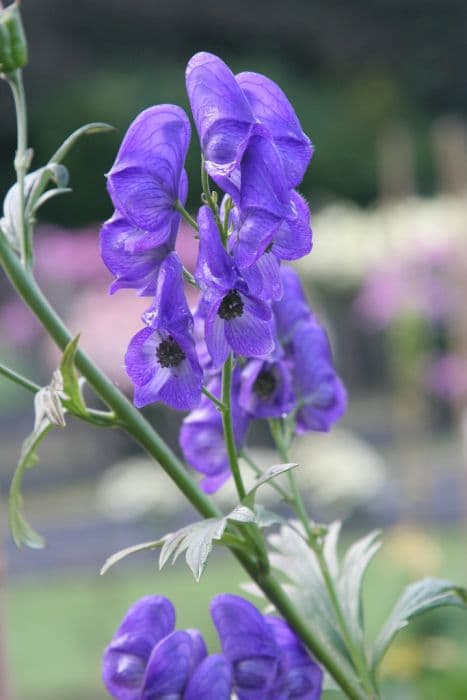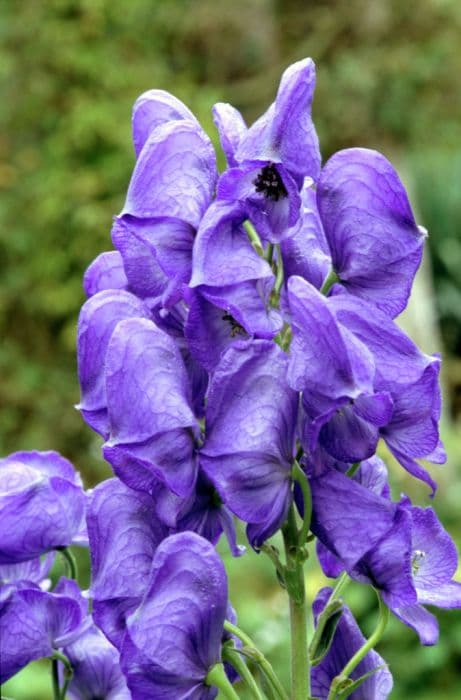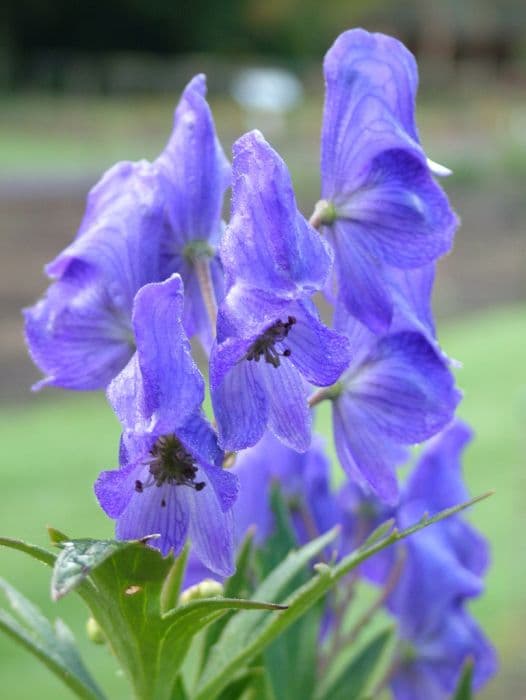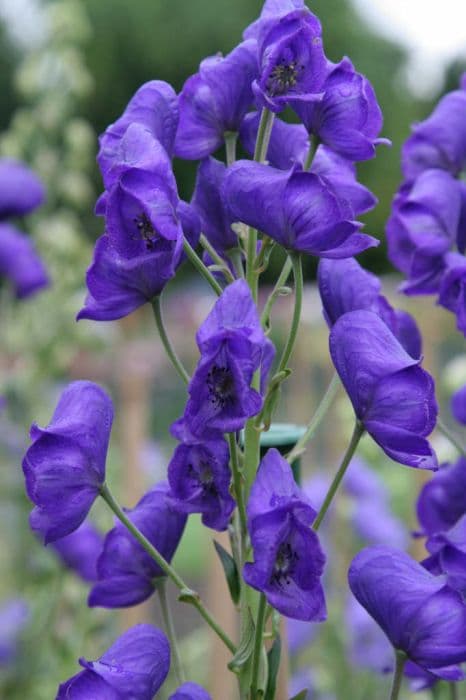Clematis Lunar Lass Clematis 'Lunar Lass' (Fo/f)

ABOUT
Clematis 'Lunar Lass' is a delightful flowering plant that adds a unique beauty to any garden. This particular cultivar is known for its striking flowers which display a charming blend of colors. The blossoms are composed of sepals rather than petals, and these sepal structures come together to form a flower-like appearance. Each sepal is soft to the touch, with a smooth texture that is visually enticing. The flowers tend to be sizeable and eye-catching, typically showcasing a pastel or creamy color palette, often intermixed with hints of greenery. Their lighter tones lend the plant its whimsical name, conjuring images of the moonlit landscapes. The foliage of Clematis 'Lunar Lass' complements its flowers perfectly. Leaves are typically bright green and arranged oppositely along the stems, creating a vibrant backdrop for the blooms. The leaves can vary in shape but are generally elongated with a pointed tip and a slightly serrated edge that adds texture to the overall appearance of the plant. As for the growth habit, Clematis 'Lunar Lass' can be characterized by its tendency to climb and sprawl. It's often found winding its way up trellises, fences, and other supports, which makes it a popular choice for vertical interest in gardens. This sprawling habit allows the plant to spread its intricate beauty, making it a lovely sight when used to adorn structures or simply allowed to meander through the landscape. Across the seasons, this Clematis cultivar continues to enchant, as its flowers bloom and bring a serene beauty to its surroundings. It is known for its seasonal blossoms, which generally ignite a renewed interest in the garden each year. Overall, Clematis 'Lunar Lass' is a captivating addition that imbues any space with a sense of elegance and charm.
About this plant
 Names
NamesSynonyms
Clematis 'Lunar Lass'.
Common names
Clematis 'Lunar Lass' (Fo/f).
 Toxicity
ToxicityTo humans
Clematis, including the 'Lunar Lass' variety, can be toxic to humans if ingested. Compounds in Clematis can cause severe irritation to the mouth, stomach, and intestines. Symptoms of poisoning can include nausea, vomiting, diarrhea, and salivation. Contact with the sap may also lead to skin irritation or dermatitis. In severe cases, ingestion can lead to internal bleeding and organ damage.
To pets
Similar to its effects on humans, Clematis is also toxic to pets. If ingested, it can cause symptoms such as drooling, vomiting, diarrhea, and, in severe cases, convulsions or collapse. Pets may also experience mouth pain or irritation, which could lead to pawing at the mouth or reduced appetite. Skin contact with the sap of the Clematis 'Lunar Lass' variety could potentially cause dermatitis in pets. It is important to prevent pets from ingesting or coming into contact with the plant.
 Characteristics
CharacteristicsLife cycle
Perennials
Foliage type
Deciduous
Color of leaves
Green
Flower color
Mixed
Height
6 feet (1.8 meters)
Spread
3 feet (0.9 meters)
Plant type
Climber
Hardiness zones
4
Native area
Varies
Benefits
 General Benefits
General Benefits- Aesthetic appeal: Clematis 'Lunar Lass' adds visual interest to gardens with its attractive, pale yellow flowers.
- Vertical interest: As a climbing plant, it can be trained on trellises, fences, and arbors, helping to create height and structure in garden designs.
- Pollinator-friendly: The flowers can attract bees and other pollinators, which are essential for the health of the ecosystem.
- Seasonal variety: It brings seasonality to gardens, with its blooming period adding color and vibrancy at specific times of the year.
- Space-efficient: Being a climber, it is ideal for smaller gardens or spaces, growing upwards rather than outwards.
- Companion planting: Clematis can be paired with other plants such as roses or shrubs to create complementary plant associations.
 Medical Properties
Medical PropertiesThis plant is not used for medical purposes.
 Air-purifying Qualities
Air-purifying QualitiesThis plant is not specifically known for air purifying qualities.
 Other Uses
Other Uses- Clematis 'Lunar Lass', commonly known as clematis, can be used in the art of kokedama, where the plant's roots are wrapped in soil and moss to create a living sculptural form.
- Clematis can be trained to grow on frames to create decorative, living privacy screens in a garden or on a balcony.
- The vigorous vines of clematis can be guided over unsightly fences or garden sheds, transforming them into vibrant floral displays.
- Clematis can be used in companion planting to climb up through shrubs or small trees, adding layers of color and texture without the need for additional support structures.
- The plant can add vertical interest to container gardens when grown on miniature trellises within the pots.
- Clematis can be used as a natural dye source; the petals may produce subtle colors when used in the dyeing of fabrics or yarns.
- Photographers often use clematis flowers as a subject or backdrop to enhance the aesthetic appeal of their compositions.
- Clematis seed heads can inspire artists or be used directly in crafting for their intricate and feathery appearance.
- Gardeners might use clematis as part of a themed garden, such as a moon garden, where the plant's pale blooms contribute to the luminescent effect at dusk and into the evening.
- During winter, the dried vine structure of clematis can provide visual interest in the garden when most other plants have died back or been pruned.
Interesting Facts
 Feng Shui
Feng ShuiThe plant Clematis is not used in Feng Shui practice.
 Zodiac Sign Compitability
Zodiac Sign CompitabilityThe plant Clematis is not used in astrology practice.
 Plant Symbolism
Plant Symbolism- Mental Agility: Clematis, commonly known as 'Traveler's Joy', often represents mental agility due to its ability to climb and adapt to its environment, symbolizing the human mind's capability to navigate life's challenges.
- Ingenuity: Its adept climbing manner suggests cleverness and the ability to find creative solutions to obstacles.
- Aspiration: The upward growth of Clematis can symbolize one's aspirations and the drive to reach higher goals.
- Artistic Inspiration: The beautiful blossoms of the Clematis may represent artistic inspiration, encouraging the viewer to engage in creative endeavors.
 Water
WaterFor the Clematis 'Lunar Lass,' commonly known as Clematis, it is crucial to maintain a consistent moisture level in the soil without overwatering, which can lead to root rot. Water the plant deeply once a week, providing about 1 gallon of water per session, ensuring that the water penetrates the soil to reach the plant's deep roots. During the hot summer months or periods of drought, you may need to water twice a week. Adjust the watering frequency based on the plant's needs, considering rainfall and temperature variations. It's essential to avoid letting the soil dry out completely, but also to prevent standing water around the roots.
 Light
LightClematis thrives best in a location where it receives at least six hours of sunlight per day, with the roots shaded or mulched. Ideally, plant your Clematis where the leaves get full sun and the roots are shaded, either by other plants or a mulch cover. If you are in a particularly hot climate, provide some afternoon shade to prevent scorching the leaves.
 Temperature
TemperatureClematis prefers a moderate climate and fares well in temperatures ranging from around 55°F to 75°F. They can withstand a freeze but perform best when temperatures stay above freezing; they can survive winter lows down to about -20°F when properly mulched. During the growing season, the ideal temperature range is from 65°F to 75°F for optimal growth and flowering.
 Pruning
PruningPrune Clematis to promote healthy growth, prevent tangling, and encourage blooming. Clematis 'Lunar Lass' should be pruned in late winter or early spring before new growth begins. It's important to remove any dead or damaged stems at this time. Some additional light pruning right after the first bloom can help encourage a second flush of flowers later in the season.
 Cleaning
CleaningAs needed
 Soil
SoilThe best soil mix for Clematis 'Lunar Lass', commonly known as Clematis, should be well-draining with a pH of around 6.5 to 7.5. A mix composed of one part compost, one part perlite or coarse sand, and one part garden soil is recommended to ensure healthy growth.
 Repotting
RepottingClematis 'Lunar Lass' typically needs to be repotted every 2 to 3 years. It's best to repot Clematis in late winter or early spring before new growth begins, using a container only slightly larger than the previous one.
 Humidity & Misting
Humidity & MistingClematis 'Lunar Lass' thrives in outdoor conditions where it can receive natural humidity. It does not require high humidity levels; average outdoor humidity is adequate for its growth.
 Suitable locations
Suitable locationsIndoor
Place in a bright spot, provide support for climbing, and keep soil moist.
Outdoor
In sun to part shade, water regularly, and provide a trellis or support.
Hardiness zone
4-9 USDA.
 Life cycle
Life cycleClematis 'Lunar Lass' (Clematis florida), like other clematis species, begins its life cycle as a seed, which germinates in suitable conditions of moisture and temperature. The seedling develops into a juvenile plant, featuring a limited root system and a few leaves. As it matures into the vegetative stage, it establishes a stronger root system and starts vigorous vine growth, clinging to supports with its leaf stems. During the flowering stage, generally in late spring to early summer, 'Lunar Lass' produces distinctive white or cream flowers that attract pollinators. After pollination, the flowers develop into fruit with feathery tails called achenes, which can be dispersed by wind. The plant then goes into a period of dormancy during the cold months, only to resume growth and complete the cycle again with the return of warmer weather.
 Propogation
PropogationPropogation time
Spring to Summer
The Clematis 'Lunar Lass', often simply referred to as Clematis, can be propagated using several methods, with the most popular being layering. This technique involves bending a low-growing, flexible stem to the ground and covering a portion of it with soil while it's still attached to the parent plant. The contact segment should be slightly wounded or notched and pegged down with a u-shaped wire to encourage rooting. To maintain moisture, it’s beneficial to apply a layer of mulch over the area. Roots usually develop at the points of contact with the soil within one growing season. Once established, the new plant can be severed from the parent Clematis and transplanted to a desired location, generally in the autumn or early spring. This method allows for the successful propagation of Clematis without the need for specialized equipment, relying instead on the natural tendencies of the plant to root and grow.

